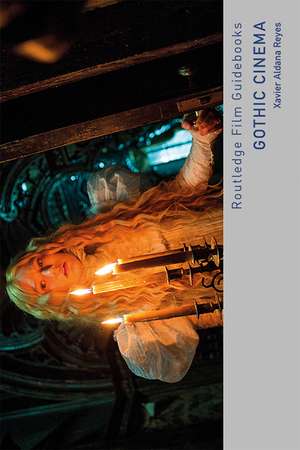Gothic Cinema: Routledge Film Guidebooks
Autor Xavier Aldana Reyesen Limba Engleză Paperback – 3 ian 2020
But what is Gothic cinema and when did it begin? Is the iconography of the Gothic film the same, or equivalent to, that of the horror genre? Are the literary origins of the Gothic what solidified its aesthetics? And exactly what cultural roles does the Gothic continue to perform for us today? Gothic Cinema covers topics such as the chiaroscuro experiments of early German cinema, the monster cinema of the 1930s, the rise of the supernatural explained in the old dark house mystery films of the 1920s and the Female Gothics of the 1940s, the introduction of colour photography in the period Gothics of the late 1950s, the European exploitation booms of the 1960s and 1970s, and the animated films and Gothic superheroes that dominate present times. Throughout, Aldana Reyes makes a strong case for a tighter and more intuitive approach to the Gothic on screen that acknowledges its position within wider film industries with their own sets of financial pressures and priorities.
This ground-breaking book is the first thorough chronological, transhistorical and transnational study of Gothic cinema, ideal for both new and seasoned scholars, as well as those with a wider interest in the Gothic.
| Toate formatele și edițiile | Preț | Express |
|---|---|---|
| Paperback (1) | 207.26 lei 3-5 săpt. | +19.91 lei 7-13 zile |
| Taylor & Francis – 3 ian 2020 | 207.26 lei 3-5 săpt. | +19.91 lei 7-13 zile |
| Hardback (1) | 623.48 lei 6-8 săpt. | |
| Taylor & Francis – 2 ian 2020 | 623.48 lei 6-8 săpt. |
Preț: 207.26 lei
Nou
39.66€ • 41.41$ • 32.82£
Carte disponibilă
Livrare economică 15-29 martie
Livrare express 01-07 martie pentru 29.90 lei
Specificații
ISBN-10: 1138227560
Pagini: 270
Ilustrații: 21 Halftones, black and white
Dimensiuni: 129 x 198 x 20 mm
Greutate: 0.45 kg
Ediția:1
Editura: Taylor & Francis
Colecția Routledge
Seria Routledge Film Guidebooks
Locul publicării:Oxford, United Kingdom
Cuprins
- Transitional Origins
- Monstrous Shadows
- Franchise Gothic
- The Explained Supernatural
- Gothic in Technicolour
- Exploitation Gothic
- Late Dispersions
Notă biografică
Recenzii
Professor David Punter, Senior Research Fellow, University of Bristol
'Aldana Reyes offers an insightful and much-needed excavation of the dark history of the Gothic on film. Rigorously researched, engagingly written and providing new perspectives and understanding, this is a must-read for film and Gothic scholars alike.'
Dr. Stacey Abbott, Reader in Film and Television Studies, Roehampton University
Descriere
Arguing for the need to understand Gothic cinema as an aesthetic mode, this book explores its long history, from its transitional origins in phantasmagoria shows and the first 'trick' films to its postmodern fragmentation in the Gothic pastiches of Tim Burton.
But what is Gothic cinema and when did it begin? Is the iconography of the Gothic film the same, or equivalent to, that of the horror genre? Are the literary origins of the Gothic what solidified its aesthetics? And exactly what cultural roles does the Gothic continue to perform for us today? Gothic Cinema covers topics such as the chiaroscuro experiments of early German cinema, the monster cinema of the 1930s, the rise of the supernatural explained in the old dark house mystery films of the 1920s and the Female Gothics of the 1940s, the introduction of colour photography in the period Gothics of the late 1950s, the European exploitation booms of the 1960s and 1970s, and the animated films and Gothic superheroes that dominate present times. Throughout, Aldana Reyes makes a strong case for a tighter and more intuitive approach to the Gothic on screen that acknowledges its position within wider film industries with their own sets of financial pressures and priorities.
This ground-breaking book is the first thorough chronological, transhistorical and transnational study of Gothic cinema, ideal for both new and seasoned scholars, as well as those with a wider interest in the Gothic.













